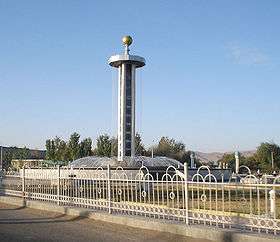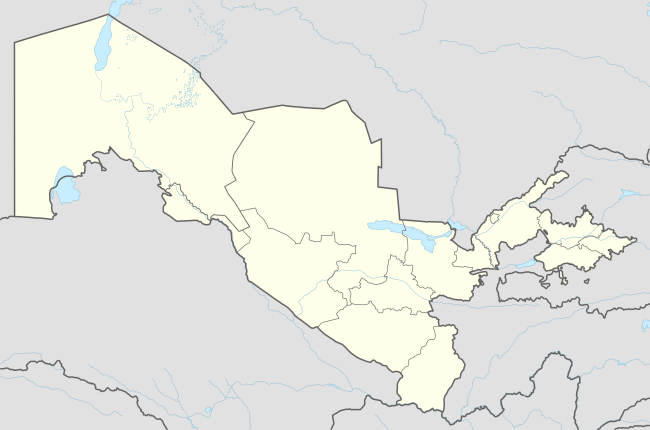Jizzakh
Jizzakh (Uzbek: Jizzax/Жиззах, جىززﻩخ) is a city (population 923,570 in 2014) and the center of Jizzakh Region in Uzbekistan, northeast of Samarkand. The population of Jizzakh on April 24, 2014, was approximately 324,136.[1]
Jizzakh Jizzax / Жиззах | |
|---|---|
 .jpg) | |
 Jizzakh Location in Uzbekistan | |
| Coordinates: 40°06′57″N 67°50′32″E | |
| Country | |
| Region | Jizzakh Region |
| First mention | 10th century |
| Government | |
| • Type | City Administration |
| Area | |
| • Total | 210 km2 (80 sq mi) |
| Elevation | 378 m (1,240 ft) |
| Population (2014) | |
| • Total | 163,200 |
| • Density | 780/km2 (2,000/sq mi) |
| Postal code | 130100-130117 |
| Area code(s) | (+998) 72 |
| Vehicle registration | 25-29 |
| Website | www |
History
Jizzakh was an important Silk Road junction on the road connecting Samarkand with Fergana Valley. It is at the edge of Golodnaya Steppe, and next to the strategic Pass of Jilanuti (Timur's Gate) in the Turkestan Mountains, controlling the approach to the Zeravshan Valley, Samarkand and Bukhara.
The name Jizzakh derives from the Sogdian word for "small fort" and the present city is built of the site of the town which belonged to Osrushana. After the Arab conquest of Sogdiana, Jizzakh served as a market town between the nomadic raiders and settled farmers. The Arabs built a series of rabats (blockhouses) at Jizzakh, housing ghazis to protect the people. By the 19th century, these blockhouses had evolved into a major fortress for the Emirate of Bukhara. Russian General Mikhail Chernyayev, the “Lion of Tashkent” failed in his first attempt to take Jizzakh, but succeed in his second try, with a loss of 6 men, against 6000 dead for the defenders. The old town was mostly destroyed, its remaining inhabitants evicted, and Russian settlers brought in.[2]
In 1916, Jizzakh was the center of an anti-Russian uprising, which was quickly suppressed. In 1917, Jizzakh's most famous native son, Sharof Rashidov, future secretary of the Communist Party of Uzbekistan, was born.
Modern Jizzakh is quietly tree-lined European, with almost nothing remaining of the pre-Rashidov era. The city has two universities, with a total of approximately 7,000 students, and is home to a football team, Sogdiana Jizzakh, which plays in the Uzbek League (Super Liga).
Climate
| Climate data for Jizzakh (1981–2010) | |||||||||||||
|---|---|---|---|---|---|---|---|---|---|---|---|---|---|
| Month | Jan | Feb | Mar | Apr | May | Jun | Jul | Aug | Sep | Oct | Nov | Dec | Year |
| Average high °C (°F) | 6.3 (43.3) |
8.9 (48.0) |
14.8 (58.6) |
22.2 (72.0) |
28.0 (82.4) |
33.7 (92.7) |
34.9 (94.8) |
33.4 (92.1) |
28.5 (83.3) |
22.0 (71.6) |
14.7 (58.5) |
8.1 (46.6) |
21.3 (70.3) |
| Average low °C (°F) | −1.8 (28.8) |
−0.4 (31.3) |
4.6 (40.3) |
10.1 (50.2) |
14.5 (58.1) |
18.7 (65.7) |
20.2 (68.4) |
18.3 (64.9) |
13.0 (55.4) |
7.8 (46.0) |
3.5 (38.3) |
−0.7 (30.7) |
9.0 (48.2) |
| Average precipitation mm (inches) | 40.7 (1.60) |
50.4 (1.98) |
63.4 (2.50) |
57.7 (2.27) |
36.4 (1.43) |
10.7 (0.42) |
4.1 (0.16) |
1.0 (0.04) |
4.7 (0.19) |
20.0 (0.79) |
40.4 (1.59) |
51.8 (2.04) |
381.3 (15.01) |
| Average precipitation days | 13 | 14 | 14 | 11 | 9 | 5 | 2 | 2 | 3 | 6 | 9 | 12 | 100 |
| Source: Centre of Hydrometeorological Service of Uzbekistan[3] | |||||||||||||
Main tourist sights
- Sharof Rashidov Memorial Museum
- Provincial Museum
Famous people born in Jizzakh
See also
References
- "О населении языком цифр" (in Russian). Archived from the original on 14 October 2014. Retrieved 6 January 2015.
- Bekchurin (1872). Туркестанская область. Заметки Бекчурина (in Russian). Kazan. p. 21.
- "Average monthly data about air temperature and precipitation in 13 regional centers of the Republic of Uzbekistan over period from 1981 to 2010". Centre of Hydrometeorological Service of the Republic of Uzbekistan (Uzhydromet). Archived from the original on 15 December 2019. Retrieved 15 December 2019.